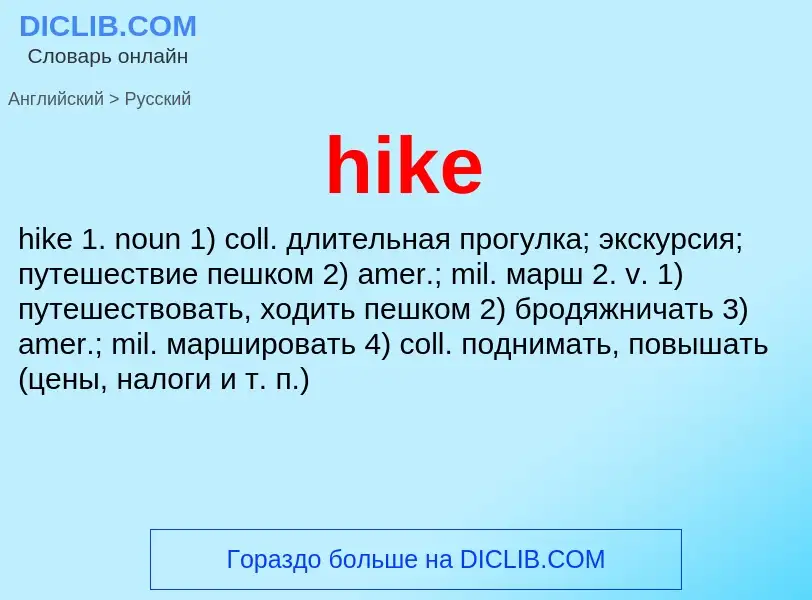Translation and analysis of words by ChatGPT artificial intelligence
On this page you can get a detailed analysis of a word or phrase, produced by the best artificial intelligence technology to date:
- how the word is used
- frequency of use
- it is used more often in oral or written speech
- word translation options
- usage examples (several phrases with translation)
- etymology
hike -er - translation to English
[haik]
существительное
[haik]
общая лексика
экскурсия
путешествие пешком
разговорное выражение
длительная прогулка
экскурсия или путешествие пешком
прибавка
повышение
увеличение (цен и т. п.)
военное дело
марш в пешем строю
марш
глагол
общая лексика
подтягивать
поднимать
подниматься
задираться
путешествовать, ходить пешком
разговорное выражение
путешествовать
ходить пешком
бродить
бродяжничать
резко поднимать (цены, ренту и т. п.)
военное дело
идти в пешем строю
маршировать
собирательное выражение
поднимать, повышать (цены, налоги и т. п.)
Definition
Wikipedia

Thru-hiking, or through-hiking, is the act of hiking an established long-distance trail end-to-end continuously.
The term is most frequently used regarding trails in the United States, such as the Pacific Crest Trail (PCT), the Appalachian Trail (AT), and the Continental Divide Trail (CDT). Globally, some examples of thru-hikes include Te Araroa in New Zealand, the Camino de Santiago in Spain and France, the Via Francigena in France and Italy, the Grand Italian Trail in Italy, the Great Divide Trail (GDT) in Canada, and the Great Himalaya Trail in Nepal, all of which are over 1,000 km (620 mi) in length.
The length for a trail to be considered a thru-hike is undefined. Trails most associated with thru-hiking often take several weeks or months to complete, but any completed end-to-end trail is technically a thru-hike. Thruhiking also usually involves backpacking and camping, though not always.
Section hiking refers to hiking a long-distance trail one section at a time. Generally, a trail completed as a collection of section hikes is not considered a thru-hike, as the trail was not completed continuously. However, hiking trail sections out of order, e.g., starting at the halfway point of the AT and hiking to the northern terminus, then flying back to the middle and hiking the southern half, still counts as a thru-hike, as long as the trail is completed in one trip.


